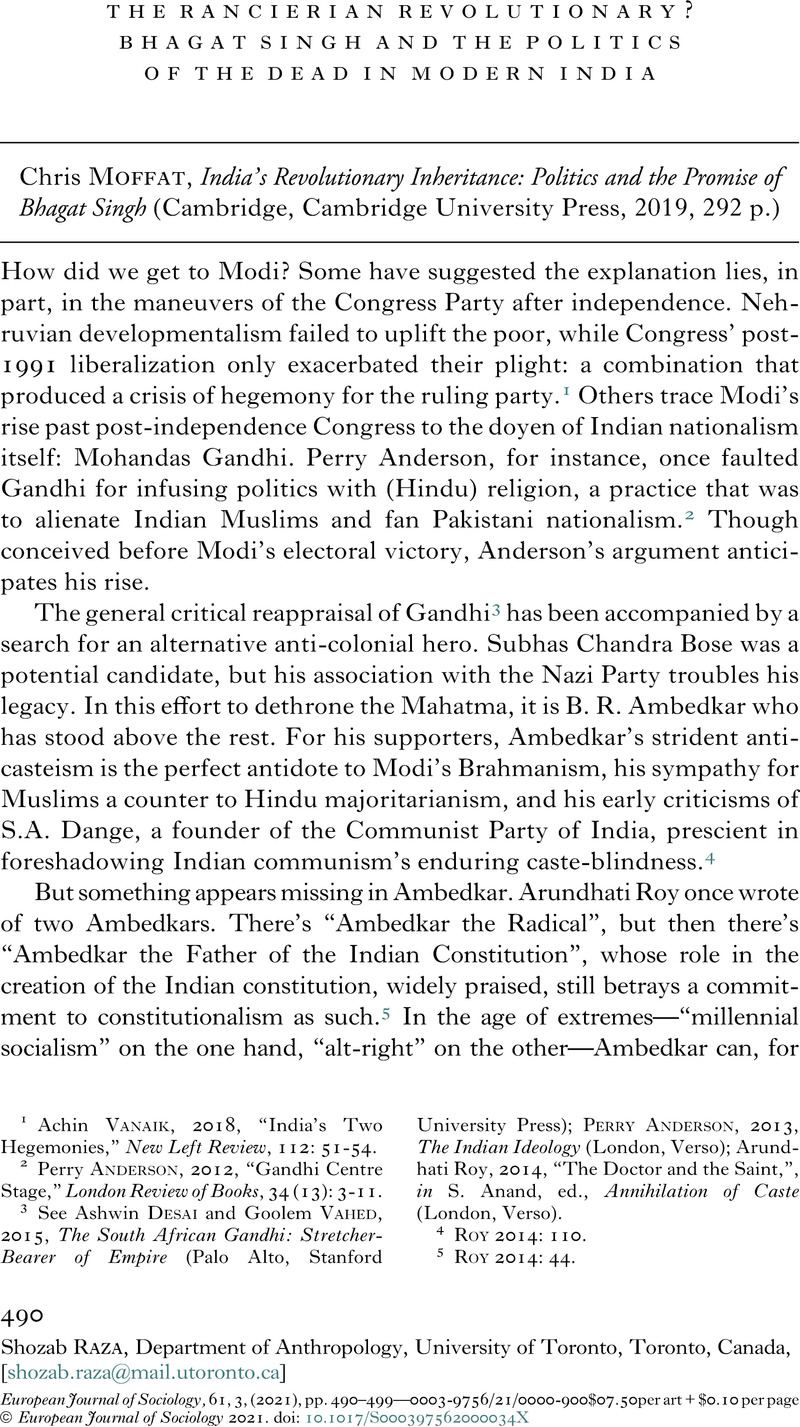No CrossRef data available.
Published online by Cambridge University Press: 26 March 2021

1 Vanaik, Achin, 2018, “India’s Two Hegemonies,” New Left Review, 112: 51-54.Google Scholar
2 Anderson, Perry, 2012, “Gandhi Centre Stage,” London Review of Books, 34 (13): 3-11.Google Scholar
3 See Desai, Ashwin and Vahed, Goolem, 2015, The South African Gandhi: Stretcher-Bearer of Empire (Palo Alto, Stanford University Press)CrossRefGoogle Scholar; Perry Anderson, 2013, The Indian Ideology (London, Verso); Arundhati Roy, 2014, “The Doctor and the Saint,”, in S. Anand, ed., Annihilation of Caste (London, Verso).
4 Roy 2014: 110.
5 Roy 2014: 44.
6 Rancière, Jacques, [1995] 1999, Disagreement: Politics and Philosophy, trans. Julie Rose (Minneapolis, University of Minnesota Press).Google Scholar
7 Sohan Singh Josh, 1976, My Meetings with Bhagat Singh and Other Early Revolutionaries (New Delhi, Communist Party of India: 16).
8 Bhagat Singh, 1986, “Letter to Father” (1923), in Shiv Verma, ed., Selected Writings of Shaheed Bhagat Singh (New Delhi, National Book Centre: 56).
9 Singh, Bhagat, 1986, “Why I am an Atheist?” (1931), in Verma, Shiv, ed., Selected Writings of Shaheed Bhagat Singh (New Delhi, National Book Centre).Google Scholar
10 See Bakshi, S. R., 1981, Bhagat Singh and His Ideology (New Delhi, Capital Publishers: 28-89).Google Scholar
11 Loomba, Ania, 2019, Revolutionary Desires: Women, Communism and Feminism in India (New York, Routledge: 94-95).Google Scholar
12 See Lenin, V. I., 1973, “Inflammable Material in World Politics”, in Collected Works, 15 (Moscow, Progress Publishers: 182-188).Google Scholar
13 Page 122, in Singh 1986, cf. supra.
14 Page 153, in “Manifesto of the Naujawan Bharat Sabha” (4 June 1928), 1986, in Shiv Verma, ed., Selected Writings of Shaheed Bhagat Singh, (New Delhi, National Book Centre).
15 Page 123, in Singh 1986, cf. supra.
16 Page 155, in “Manifesto of the HSRA” (1929), 1986, cf. supra.
17 Ibid.: 155.
18 “Statement of Bhagat Singh and B.K. Dutt in the Assembly Bomb Case” (1929) [shahidbhagatsingh.org, http://www.shahidbhagatsingh.org/index.asp?link=june6].
19 Page 76, in Singh, Bhagat, 1986, “On the Slogan of Long Live Revolution”, in Verma, Shiv, ed., Selected Writings of Shaheed Bhagat Singh (New Delhi, National Book Centre).Google Scholar
20 See page 82, in Verma, Shiv, ed., 1986, Selected Writings of Shaheed Bhagat Singh, (New Delhi, National Book Centre).Google Scholar
21 See pages 63 and 66, in Judge, Paramjit S., 1992, Insurrection to Agitation: The Naxalite Movement in Punjab (Bombay, Popular Prakashan).Google Scholar
22 Chandan, Amarjit, 1974, Chithiaan: Shaheed Bhagat Singh te Saathi (Amritsar, Balraj Sahni Yadgar).Google Scholar
23 Pages 113-120, in Singh, Bhagat, 1986, “To Young Political Workers,” in Verma, Shiv, ed., Selected Writings of Shaheed Bhagat Singh (New Delhi, National Book Centre).Google Scholar